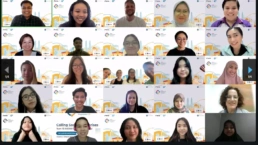In today’s hyperconnected digital world, content is no longer just king, it is the engine that drives awareness, engagement, and change. This was one of the key messages in the fourth virtual session of the ASEAN SEDP 4.0, where participants delved into Content Strategy, led by Benedict Wermter, a journalist and the voice behind @bulesampah on 17 June 2025
Benedict opened the session by challenging traditional storytelling. “We need to be innovative, especially when dealing with complex topics like plastic waste,” he said. He stressed that the role of social media is not merely to inform, but to translate intricate problems into visually appealing, digestible, and compelling narratives that spark real conversations and impact.
The strategy lies in the idea that content should not just communicate but also mobilise people.
Benedict explained “Your content must help shape opinions. Give your audience the confidence to speak up, to share concerns, and to become active participants in change. This is about empowerment with democratic values.” He continued, “Then, go beyond awareness. Use interactive content to cultivate a readiness for behavioural change.”
Benedict shared some ‘secret sauces’ of digital engagement through crowdsourcing and crowd reporting. Both are grassroots-driven techniques that allow social enterprises to close information gaps by inviting the public into the storytelling process.
Take waste management, for instance. Instead of assuming what the community needs, a simple question like “Are there any other waste stations we should visit?” can unlock a wealth of local insights. Crowdsourcing, he noted, is not just data collection, it’s a democratic conversation.
Similarly, crowd reporting transforms passive audiences into active informants. By encouraging citizens to share real-time evidence, such as videos of local pollution, social enterprises can build powerful, authentic narratives sourced from the communities they aim to serve. “It’s the people’s voice that creates urgency,” he emphasised.
But even the best story needs direction, and that’s where a well-crafted Call to Action (CTA) comes in. Ben explained that the CTA is not about ‘like and subscribe’. Instead, he urged enterprises to be bold and purposeful. Whether it’s urging people to sign a petition, reduce plastic usage, or share a personal story, an effective CTA gives content a mission, and viewers a role to play.
As ASEAN’s social enterprises continue to tackle environmental and societal challenges, mastering the art of storytelling is no longer optional, it’s essential. With the right strategy, every post, video, or comment can become a ripple in a much larger wave of change.


